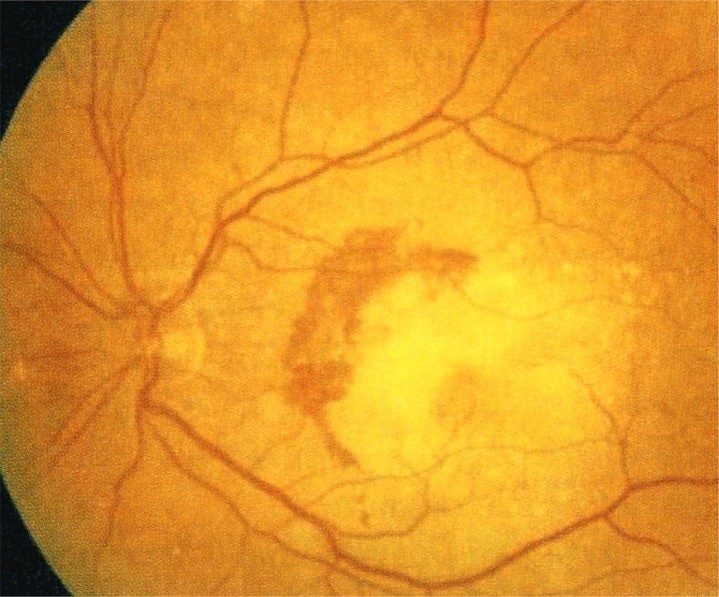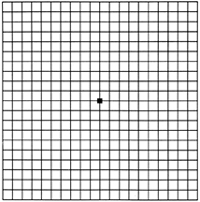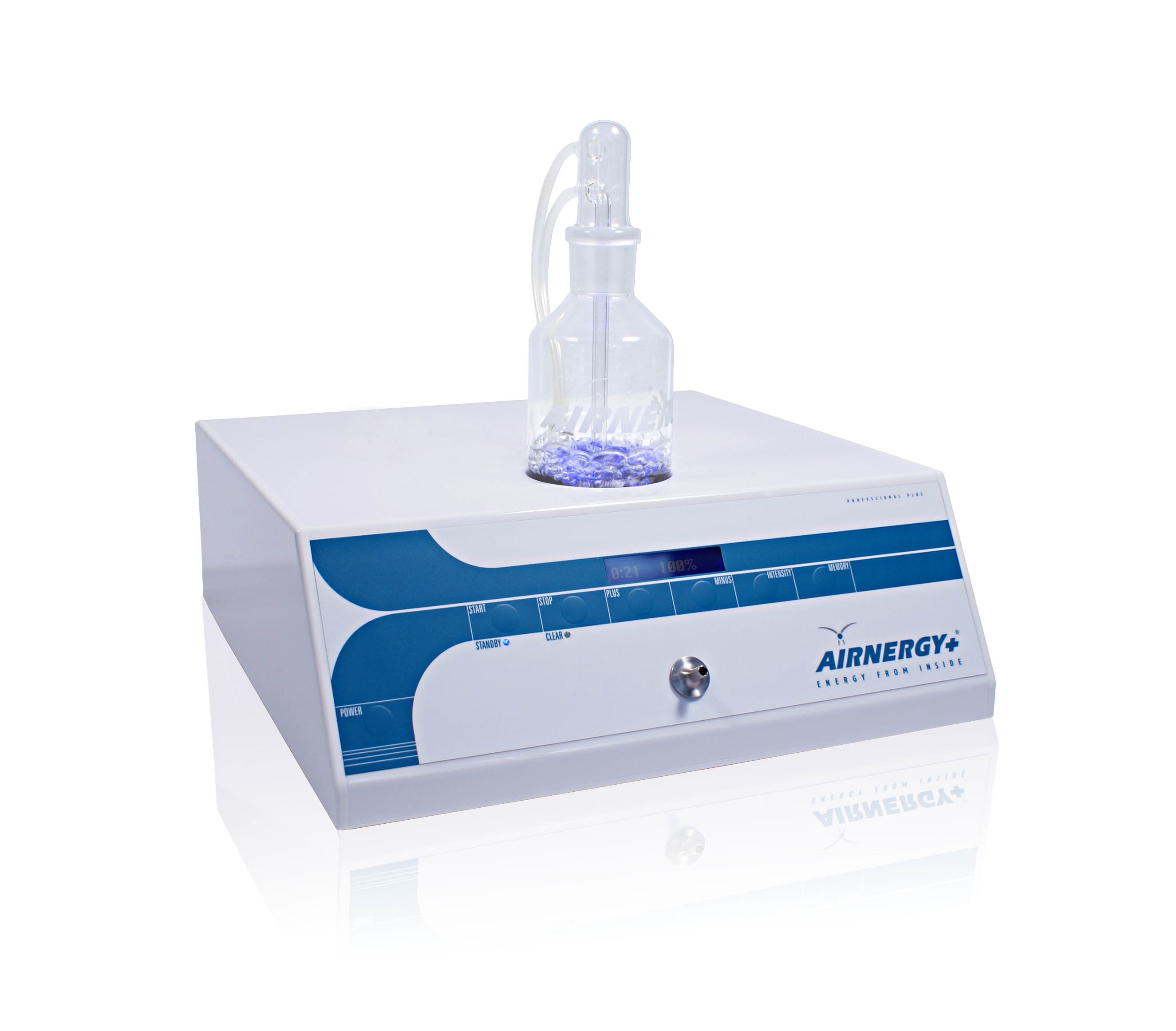Spirovitalisation Therapy – a complementary therapy option for age-related macular degeneration (AMD)
Univ.-Prof. Dr. med. Klaus Jung, Mainz University
Case study:
Mrs A.K.L. had an operation in 1995 to remove cataracts from both eyes. Since that time she has been known to have macular degeneration in the right eye, which the University Hospital categorised as being untreatable.
In 2002 her eye specialist told her about the possibility of improving her eye condition by using a new treatment option to enhance oxygen utilisation (Spirovitalisation / Airnergy).
The first few applications did not bring about any change in her ophthalmological status, even though she experienced huge improvements in her general well-being and several complaints resulting from injuries.
With further use the patient herself and also her therapist stated that there had been an “unbelievable” reduction in the shadow in her central field of vision so that her eyesight was almost normal for driving, facial recognition and for reading.
Physiology:

Electromagnetic radiation with wavelengths of between 400 – 750mm is perceived as “light”. In order to make an image, the light incident into the eye has to be refracted (lens, cornea) and projected onto the retina, a light-sensitive membrane at the back of the eye-ball. To perform its function the retina contains special nerve cells (rod-shaped photoreceptors for perceiving light/dark and cone-shaped photoreceptors for distinguishing between colours), which convert the light energy into nerve impulses. The impulses are then transmitted from the retina via other cells and pathways to the brain, where they trigger certain “perceptions”.
The area on the retina that is able to perceive the finest details is known as the “yellow spot” or “macula”. It surrounds the fovea (pit), which contains the highest density of visual cells (approximately 30,000 cones directly connected to the brain). This spot that is only a few mm2 in size is responsible for important visual functions such as reading, recognising faces, distinguishing details, stereoscopic (spatial) vision and perception of colours. On the other hand the rest of the retina primarily perceives outlines and light/dark contrasts (rod cells).
The macula has a high metabolic rate and therefore a high oxygen requirement. Metabolic end-products are absorbed by the pigment epithelial cells that lie underneath the macula and are taken away or disposed of locally (radicals). This process can be disrupted with increasing age or prematurely due to illness.
Definition:
“Age-related macular degeneration” (AMD) is understood to be a disease of the retina, in which the point of the sharpest vision (macula), that is only a few millimetres in size, is increasingly damaged. In concrete terms the tissue degenerates and wastes until eventually it dies. In addition to this, pathological proliferations of cells and capillaries can form and these impair the macular functions even further.
A distinction can be made between two different forms of the disease:
1. Dry macular degeneration:
In this form there is increased deposition of metabolic end-products. These hinder blood circulation and therefore metabolism. This primarily affects the “retinal pigment epithelium” (RPE), a layer that lies beneath the visual cells and is responsible for their metabolism (supply/disposal).
2. Wet macular degeneration:
This can develop from the dry form in that, because of the restricted metabolic function, new capillaries form and these lift the retina and because of their greater water permeability result in oedema.
Statistics:
Throughout the world there are said to be between 25 and 30 million people suffering from macular degeneration with approximately 500,000 new cases per year, a rising trend because of the increasing average life expectancy. The frequency of the disease in Germany is calculated at between 2.5 – 4 million. Approximately 20% of all 65 – 74-year-olds and 35% of over-75s are affected. Every year there are approximately 50,000 new cases to add to this so that one can quite justifiably speak of a national disease.
The most common form of macular degeneration is age-related or senile AMD, which primarily occurs after the age of 60. It represents the main cause of central blindness in industrialised countries.
Etiology – Pathogenesis:
So far the causes of macular degeneration have not been clearly explained. It has been discussed that nearly everybody would be affected at the corresponding age so that genetics and environmental factors “merely” determine the time of onset. Smoking, high blood-pressure, being overweight and excessive exposure to sunlight are the main risk factors.

It is commonly believed that at the start of the disease there is increased formation of oxygen radicals and inadequate disposal of the same (restricted microcirculation) so that reactions are triggered in the centre of the retina that eventually result in the destruction of photo-sensitive cells. At this stage this is known as “dry” macular degeneration, the most frequent form (approximately 80%).
In “wet” macular degeneration (approximately 20%), that can develop from the “dry” form, small capillaries sprout underneath the retina resulting in the formation of oedema. This acts like an isolating layer that consequently impairs the oxygen supply to the retina even further.
In summary an increased incidence of oxygen radicals on the one hand and increasing restriction of optimum oxygen supply on the other are obviously primarily responsible for the arising of AMD, an indication for the possibility of Spirovitalisation (supply of energised respiratory air using the “Airnergy” principle) for either preventing or treating it.

Clinical studies:
Changes in the centre of the retina can be identified ophthalmologically long before subjective restrictions are experienced, documenting the importance of appropriate preventative examinations.
Subjective symptoms can be the distortion of straight lines (window frames, house walls), fading of colours, swimming of words (newspaper) and black (empty) spots in the centre of the visual field. Everyday activities such as reading, watching television, driving and recognising faces become increasingly difficult, contrasts blur, contours distort. Eventually only schematic outlines can be recognised.
Sometimes only one eye is affected initially so that the restriction is hardly noticed.
General Treatment:
As regards dry macular degeneration, in particular its early form, it is currently almost unanimously argued that there is no specific treatment but that it is necessary to monitor for any possible general risk factors that might reduce it (smoking, high blood-pressure, being overweight, excessive exposure to sunlight). From a naturopathic point of view supplementary treatments would be moderate exercise therapy, in particular endurance sport, monitoring for adequate nutrition (avoiding saturated fats, preferring monounsaturated and polyunsaturated fats, adequate intake of vitamins, minerals and antioxidants) and a harmonious lifestyle (avoiding stress or stress reduction or compensation techniques).
This context provides clear indications about the importance of neutralising oxygen radicals and improving the supply of oxygen to the structures of the inner eye.
Even when the later form of “dry” macular degeneration is present, but particularly with the “wet” form, various therapeutic methods are recommended by the specialist associations: Photodynamic therapy (PDT), laser therapy and photocoagulation, macugen/lucentis and avastin injections, oral administration of vitamins and minerals, retinal rotation and macular translocation as well as cortisone/triamcinolone injections. Alternative therapists supplement with various acupuncture treatments, radiation therapy, macular glasses and behavioural changes.
Again and again patients report that their severe visual impairments have been reduced by non-conventional therapies (that they nevertheless regard as being highly effective) to such an extent that they were able to resume many activities that they had been unable to do for years. The most noticeable of these improvements are in the blood circulation in the affected vessels and also (and especially) activation of retinal processes (whatever that is understood to mean but certainly aspects that go way beyond medical processes).
Spirovital Therapy:
Experts acknowledge that pathological metabolic processes on the one hand (increased production of oxygen radicals in the macula, increased deposition and/or reduced neutralisation of the same , delayed removal or metabolisation), reduced oxygen supply of the highly-oxygen-dependent macular cells on the other (atheromatosis and/or arteriosclerotic processes of the supplying arteries, functionally disturbed circulation of the supplying arterioles and capillaries, disturbed flow of the venoles and therefore reduced supply of oxygen, possibly delayed/reduced release of oxygen and/or impaired utilisation of oxygen in the mitochondria) lead to degeneration of the macula, in most cases initially to “dry” age-related AMD, after many years developing into the “wet” form.
Oxygen deficit and oxygen radicals play a determining role in AMD and so Spirovitalisation has become of interest to many sufferers and their therapists as a possibly effective basic therapy.
The principle of Spirovitalisation consists of the short-term elevation of the oxygen in the atmospheric air from its normal state (triplet oxygen 3O2) to a higher energy level (singlet oxygen, 1O2) under the effect of light of a specific wavelength in the presence of a specially-selected photosensitiser. However, this elevated energy state of oxygen “only” lasts for fractions of a second before the energy that is released on its reversion to the normal state is given up to the water molecules in the air (conservation of energy principle) and inhaled together with the “normal” atmospheric oxygen of the ambient air that is saturated with water vapour and distributed throughout the entire organism.
These correlations are theoretically derived and practically confirmed by corresponding studies (increase in oxygen release, increasing of oxygen utilisation, stabilising of oxidative equilibrium) for three vital, energy – dependent metabolic areas:
Better liberation of oxygen from its bond in the red blood corpuscles (multiplication of 2.3-Biphosphoglycerate in the erythrocytes, which shifts they oxygen binding curve to the right so that, at the same partial oxygen pressure in the erythrocytes, oxygen saturation drops or the release of oxygen to the tissue, i.e. also into the individual cells of the body and there into the mitochondria, the place of ATP production, is improved).
Better utilisation of the oxygen in the cell-linked power stations (mitochondria) to create the most important energy store in body (ATP) (activation of cytochrome oxydase, which induces an enhanced reaction of the electrons released in the respiratory chain with oxygen and therefore increased oxidative phosphorylation).
Enhanced neutralisation of oxygen radicals (reduction of NADPH oxydase activity, thereby reduced formation of oxygen radicals or increased anti-oxidative capacity).
From the available experience and knowledge that has been analysed so far it appears that Spirovitalisation represents a complex intervention in the bio-cybernetic and bioenergetic functional sequences of the organism, which, by harmonising the basic regulation in the cells and in the extracellular matrix, leads to improved oxygen supply to all structures and there to enhanced O2 utilisation and thereby activates the endogenous energy production (ATP) and contributes to regulation of cellular metabolism in the whole organism.
Both preventatively and curatively, Spirovitalisation activates and supports necessary bioregulatory processes in the sense of a complete and universally-applicable measure. As a basic therapy it accompanies and promotes both prevention and rehabilitation, performance optimisation, acceleration of regeneration, clinical treatment concepts and conventional medical interventions.
An evaluation of end-user information on the effectiveness of Spirovitalisation in organic diseases showed that it had successfully been used in disorders of the nervous system, respiratory tract, cardiovascular system, locomotor system, endocrine system, in metabolic diseases, eye conditions, pain and immunological insufficiency.
In the case of functional disorders end-users assessed the effects of Spirovital therapy on energy status (performance, activity, resilience, strength, motivation), well-being (sleep quality, mood, breathing, digestion, immune status), regeneration (deepening, accelerating, relaxing, pulse lowering) and on the sensory system (smell, eye-sight, skin, dizziness) as being consistently positive.
As far as the therapists’ assessment goes, they found that Spirovital therapy could usefully be used for organic diseases in dentistry, oncology, respiratory tract diseases, eye conditions, disorders of the locomotor system, the cardiovascular system, the immune system, in metabolic diseases, as an anti-ageing method and for pain as well as for inflammation and post-operatively.
In the therapists’ opinion Spirovital therapy has a favourable effect upon functional disorders, in particular a drop in performance, absence of well-being, sleep disorders, immune insufficiency and poor eye-sight.
Confirmation of effectiveness by patients and therapists:
The medical documentation centre has numerous reports from patients and their therapists about the use of Spirovital therapy in the treatment of the dry form of macular degeneration, the subjective changes in pain, visual performance and general well-being as well as the objective findings from eye tests and ophthalmoscopy.
So far there are no known negative effects, side-effects or contraindications for Spirovital therapy. In their own words many patients said they had experienced a “real miracle” with such great improvements that some of them must be mentioned here.
- Report from natural health professional H.S.:
76-year-old female patient, after 10 sessions of combined Spirovital and Dermovital therapy (local application of energised air), an increase of between 30 – 50% in visual performance, improvement fully maintained after two year observation period and further sessions.
- Report from patient W.F. (Sweden):
“As regards my visual capacity I would like to say that’s my macular degeneration (dry) not only ceased to get worse within approximately 3 – 4 weeks of the first and then three – four times daily x 20 min oxygen therapy sessions but for a few weeks now there have been days where I can see perceptibly better especially in the close-up reading range, i.e. I can see and read with fewer gaps in letters and numbers”.
- Report from eye specialist C.C.:
“The indications where I use Spirovital therapy are circulatory disturbances of the retina and diseases of the optic nerve, also losses in the visual field following a stroke. The patients receive between five and ten x 20-min treatments. Their visual field is then tested, the back of the eye examined and they are asked about their general well-being. The patients’ feed-back is generally very positive. As a rule there are clear objective improvements in visual performance, sometimes up to two levels of visual acuity. Disorders are often significantly reduced, even though seldom totally eliminated. As a rule the quality of life is significantly improved in most patients.”
- Report from patient M.W. (England):
Macular degeneration had left Mr. W. with only 10 percent vision in both eyes and he could barely see at all by the time an ophthalmologist began to treat him with spirovitalisation. “After the treatments the first test was done and it showed an improvement of almost 40 percent in the left eye. But vision in the right eye remained at about 10 percent. By using the treatment at least four times a week, the vision continued to improve, especially the left eye, which is now at almost 60 percent. And when we did the last test we found for the first time that vision in the right eye had also improved from 10 to about 15 percent”.
- Report from G.R. about his mother (Switzerland):
80-year-old, typical macular degeneration (left eye totally blind, right by 30% vision). After three months of Spirovitalisation shadowy vision on the left (approximately 5% vision according to ophthalmoscopic assessment), vision in right eye improved from 30 to 60%. She feels generally very well.
- Report from natural health professional H.M.:
“I myself have AMD (wet on the right, dry on the left). Based on my own experience I have developed my own biological holistic therapy: two week long combined Spirovital/Dermovital therapy (local application of energised air) and 30 acupuncture treatments during this period. From this treatment many of my patients report a significant subjective improvement in their vision even during the treatment phase. Objectively measured, it was possible in one patient to reduce the wet form of AMD into the dry form.”
Summary:
Macular degeneration is the slow, progressive destruction of the most sensitive area of the retina at the back of the eye, accompanied by progressive loss of vision. The main risk factors are smoking, high blood-pressure, direct sunlight and being overweight, pathophysiologically an over-accumulation of oxygen radicals and an oxygen deficit of the highly-oxygen-dependent (metabolically active) macular cells. Airnergy therapy, i.e. the inhalation of energised air, is a basic treatment to compensate for both of these aspects that optimises the supply of oxygen to the individual cells, its liberation and its utilisation in the mitochondria leading to increased ATP generation. Many statements by patients and also by their therapists provide evidence of objective improvements in visual capacity but especially of the subjective experience of reduction in the previous extent of loss of sharp vision and the central visual field as well as an increase in general well-being.
References:
- Beers, M.H., Berkow, R. (Hrsg.): „Das MSD Manual“, Urban & Fischer, Stuttgart 2000
- Böhm, M., Jockenhövel, F., Weidner, W. (Hrsg.): „Männersprechstunde. Das Praxishandbuch zu Beratung, Prävention und Therapie“, Springer, Berlin 2004
- BVA (Berufsverband der Augenärzte Deutschlands), DOG (Deutsche Ophthalmologische Gesellschaft) (Hrsg.): „Die altersabhängige Makuladegeneration (AMD)“, Düsseldorf/München 2007
- Goldmann, D.R. (Hrsg.): „Praxishandbuch Medizin & Gesundheit. Wissen, Ratschläge, Selbsthilfe“, Dorling Kindersley, London 2002
- Jacobi, G., Biesalski, H.K., Gola, U., Huber, J., Sommer, F. (Hrsg.): „Kursbuch Anti-Aging“, Thieme, Stuttgart 2005
- Jung, K.: „Traditional oxygen therapies compared with the progressive principle of spirovitalisation“, CoMed 12(2011)1-4
- Klimpel, S., Jung, K.: „Medical and Scientific Compendium Spirovital-Therapy woth Airnergy“, Airnergy, Hennef 2011
- Medical Tribune. „Altersabhängige Makuladegeneration. Verlust der Lesefähigkeit“, 28.6.2010, http:/www.medical-tribune.de/patienten/news
- Neuhann, T.: „Altersbedingte Makuladegeneration“, http:/www.a-a-.de/leistungen/wieder-besser-sehen/altersbedingte-makuladegeneration
- Ostendorf, G.-M.: „Altersabhängige Makuladegeneration: Neue ehandlungsansätze“, Bericht über den Kongress der DOG (Deutsche Ophthalmologische Gesellschaft), Berlin 29.9 – 2.102011
- Schmidt, R.F., Thews, G., Lang, F. (Hrsg.): „Physiologie des Menschen“, Springer, Berlin 2000
- SOS Augenlicht e.V.: „Rund um Makuladegeneration“, http:/www.makuladegeneration.org